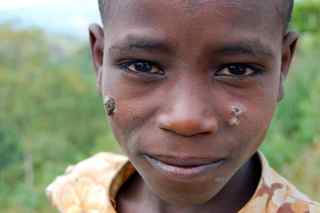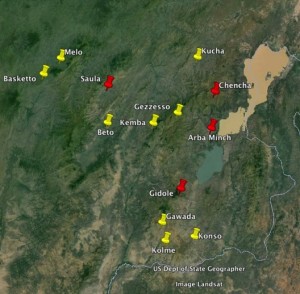The Arba Minch Hospital HIV Cohort Study
This cohort study, which started in 2002, is Arba Minch Hospital in south Ethiopia. This public hospital is located 500 Km south of Addis Ababa. The hospital serves a population of about 1.5 million in the Gamo Gofa Zone of the Southern Nations’, Nationalities’, and Peoples’ Regional State.
Registration of patients into HIV care started in January 2003 (AMH HIV cohort). ART started in August 2003 with technical support from the University of Bergen in Norway.
In the AMH HIV Cohort we include all patients registered at the ART clinic. We test, treat and follow patients according to the Ethiopian treatment guidelines. HIV positive patients with WHO stage I-IV are evaluated for treatment. During the first years, patients in stage I and II, received treatment if they had a total lymphocyte count (TLC) of less than 1200/mm3 or CD4 count of less than 200cells/ mm3. Since 2006, we started treatment with CD4 count less than 350 cells/ mm3 for WHO stage III patients. Patients with WHO stage IV disease received treatment irrespective of the TLC or CD4 results.
Following HIV testing and counselling and after recording basic socio-demographic data, a doctor examines all HIV infected patients. Following adherence counselling, we start treatment on eligible patients willing to be treated. We record all patient information using standardized national intake forms and registers in a database.
During the early phase of ART in Ethiopia we used generic combinations of stavudine (d4T), lamivudine (3TC), nevirapine (NVP), zidovudine (ZDV/AZT), and Efavirenz (EFV). Later, we included Tenofovir (TDF). Second-line drugs include Didanosine (DDI), Abacavir (ABC), TDF, and ZDV (if not used as first line regimen), Ritonavir (RTV), Lopinavir (LPV/r), Nelfinavir (NVR), and Indinavir (INV).
This cohort earlier reported on the first documentation on ART use in Ethiopia (1-3), and showed that ART improved survival and reduced sickness among people living with HIV. However, compared with patients from well-resourced settings, patients have higher early mortality rates (4). Although we documented declines in opportunistic infections (OIs) and tuberculosis, high TB incidence among patients receiving ART remains a challenge.
Based on data from the same cohort, we documented the costs of an ART programme, and showed that ART is cost-effective in a district hospital setting in Ethiopia (5, 6).
Currently the cohort contains about 2500 patients, and our latest study (7) shows that patients over the last years started to present at earlier stages of their illness, and death has decreased among adult HIV patients visiting Arba Minch Hospital. However, many patients were lost from pre-treatment follow-up. Early treatment start contributed to improved survival. We advise to develop new tools for both pre-ART and on-ART patient retention mechanisms.
New Cohort studies
We also plan to start similar studies at other hospitals and health centres in Ethiopia. These studies are planned in Sidama.
References
1. Jerene D, Lindtjorn B. Disease Progression Among Untreated HIV-Infected Patients in South Ethiopia: Implications for Patient Care. J Int AIDS Soc. 2005;7(3):66.
2. Jerene D, Naess A, Lindtjorn B. Antiretroviral therapy at a district hospital in Ethiopia prevents death and tuberculosis in a cohort of HIV patients. AIDS Res Ther. 2006;3:10.
3. Jerene D, Endale A, Lindtjørn B. Acceptability of HIV counselling and testing among tuberculosis patients in south Ethiopia. BMC International Health and Human Rights. 2007 Jan 1.
4. Jerene D, Endale A, Hailu Y, Lindtjørn B. Predictors of early death in a cohort of Ethiopian patients treated with HAART. BMC Infectious Diseases. 2006;6:136.
5. Bikilla AD, Jerene D, Robberstad B, Lindtjorn B. Cost estimates of HIV care and treatment with and without anti-retroviral therapy at Arba Minch Hospital in southern Ethiopia. Cost Eff Resour Alloc. 2009;7:6.
6. Bikilla AD, Jerene D, Robberstad B, Lindtjørn B. Cost-effectiveness of anti-retroviral therapy at a district hospital in southern Ethiopia. Cost Eff Resour Alloc. 2009 Jul 17;7(1):13.
7. Mulissa Z, Jerene D, and Lindtjørn B. Patients Present Earlier and Survival Has Improved, but Pre-ART Attrition Is High in a Six-Year HIV Cohort Data from Ethiopia. PLoS ONE 5(10): e13268. doi:10.1371/journal.pone.0013268

 This difference persists also when controlling for age, clinical stage and number of CD4 cells at treatment start Both men and women received the same treatment. Does anyone know about similar trends from other countries?
This difference persists also when controlling for age, clinical stage and number of CD4 cells at treatment start Both men and women received the same treatment. Does anyone know about similar trends from other countries? The picture shows a boy with cutaneous leishmaniasis from Ochollo. Ochollo is about 35 km north of Arba Minch, and is a place were people live in close contact the hyrax, the animal that is the reservoir of the disease.
The picture shows a boy with cutaneous leishmaniasis from Ochollo. Ochollo is about 35 km north of Arba Minch, and is a place were people live in close contact the hyrax, the animal that is the reservoir of the disease.
